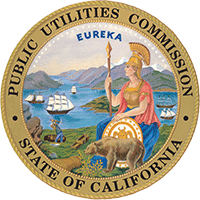Understanding How the CPUC Processes a General Rate Case
Ensuring Just and Reasonable Rates for Customers

General Rate Cases (GRCs) are among the most important and complex proceedings the California Public Utilities Commission (CPUC) undertakes. In these proceedings, the CPUC oversees an evidentiary process, requiring each utility to present evidence to support forecasts of costs to operate and maintain its system and subjecting this evidence to scrutiny and cross-examination. These decisions directly shape the rates customers pay for essential services like electricity and natural gas.
For large investor-owned utilities such as Pacific Gas and Electric Company, Southern California Edison, and San Diego Gas & Electric, GRCs are filed every four years and are processed in two distinct phases:
- Phase 1: Determines the total amount of money (called a revenue requirement) the utility needs to operate and maintain infrastructure and provide services to customers.
- Phase 2: Decides how to allocate that approved revenue requirement among different customer groups (e.g., residential, commercial, industrial).
As the Deputy Executive Director for Energy and Climate Policy at the CPUC, I’d like to share with you information on how we tackle Phase 1 of GRCs to provide clarity on the process and its transparency to the public.
What Makes a GRC So Complex?
GRCs are comprehensive and highly technical. They involve forecasts of nearly every aspect of a utility’s operations ranging from infrastructure and safety investments to customer service and cybersecurity. The CPUC assigns a multidisciplinary team of more than 30 staff, including engineers, financial analysts, policy experts, attorneys, and Administrative Law Judges (ALJs), to evaluate each utility GRC application. The goal is to ensure that utilities justify the costs necessary to provide safe, reliable utility service.
What Does a GRC Contain?
A single GRC can generate thousands of pages of documentation. The following are key components:
- Utility Testimony and Workpapers: The utilities submit detailed applications that include historical data and forecasts of future spending. This covers a wide range of activities and cost areas, including:
- Infrastructure replacement and grid upgrades
- Inspection and maintenance programs
- Wildfire mitigation and climate resilience
- Customer service and call centers
- IT systems, cybersecurity, and data management
- Employee training, benefits, and staffing
- Insurance, legal, and regulatory costs
Developing these forecasts is a massive undertaking for the utility, often beginning over a year before filing. After the filing, there are numerous opportunities for public input.
- Intervenor Testimony and Analysis: Intervenors such as consumer advocates, local governments, and environmental groups play a critical role. They submit expert testimony analyzing a utility’s forecasts, often offering alternative assumptions or recommendations. In large GRCs, more than 20 intervenors may participate, building the record with technical information and analysis.
- Public Forums and Comments: CPUC Commissioners and ALJs, supported by the Public Advisor’s Office, hold virtual and in-person Public Forums (formally called Public Participation Hearings) across a utility’s service area to gather direct input from customers. Additionally, the CPUC accepts written public comments through its online docket. These perspectives are vital and are considered in the decision-making process.
- Evidentiary Hearings: Formal Evidentiary Hearings provide the opportunity for parties to cross-examine utility and intervenor witnesses. Testimony from these hearings becomes part of the official record and is reviewed by the ALJs and CPUC when crafting the final decision.
How Does the CPUC Evaluate a GRC?
Each GRC decision can span hundreds of pages, with detailed findings on dozens of utility programs and cost forecasts. To guide this process, subject-matter experts from across the CPUC’s Divisions collaborate closely with ALJs and the Commissioner assigned to the GRC. Key roles include:
- Energy Division and General Rate Case Staff: Assess a utility’s proposed revenue requirement, financial models, and ratemaking methodology.
- Distribution Planning Staff: Evaluate proposals for infrastructure upgrades, grid modernization, and maintenance planning.
- Electric Costs & Accountability and Safety: Analyze wildfire mitigation strategies and risk reduction proposals.
- Affordability and Rates Staff: Review impacts on customer bills and assess how proposals align with affordability metrics.
CPUC staff provide in-depth issue analyses, pose data requests to utilities to clarify assumptions, and prepare recommendations that shape the proposed and final CPUC decisions.
From Filing to Decision: An 18-Month+ Process
The GRC process spans approximately 18 months from the time a utility files its application to the CPUC’s final decision. Throughout this time, CPUC staff:
- Conduct technical analysis and modeling
- Review testimony and legal briefs of the parties
- Participate in hearings and workshops
- Assist in drafting a Proposed Decision
- Support the Voting Meeting and final adoption of the case outcome
Why GRCs Matter
At its core, a GRC is about evidence and accountability. Utilities are granted the opportunity to collect revenue based on the reasonable cost of providing service. The CPUC ensures that these requests are thoroughly reviewed, justified, and in the public interest, and we do so through an open and transparent process in which the voice of the consumer is very necessary and solicited.
Every GRC decision represents months of rigorous technical analysis and stakeholder input, and reflects our commitment to ensuring that Californians have access to utility service that is safe and reliable at just and reasonable rates.

